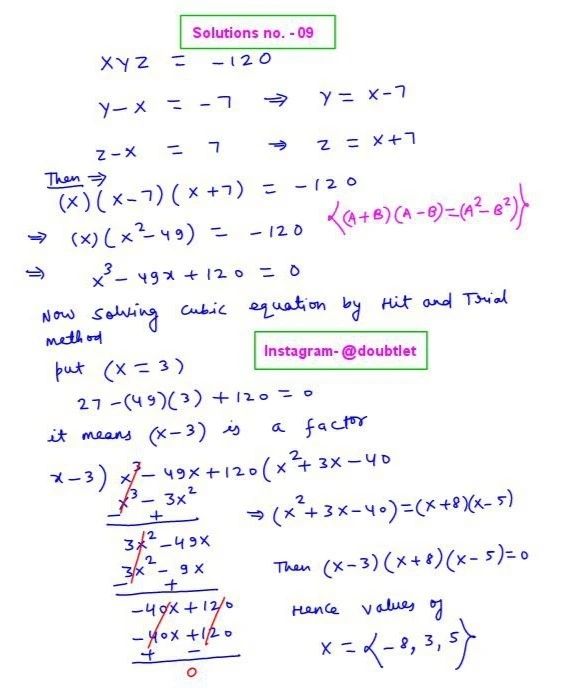









A Cofactor Matrix is a matrix where each element is replaced by its cofactor, which is determined by finding the minor of the element and applying a sign based on its position. It is crucial in matrix operations such as finding the determinant, adjugate, and inverse of a matrix, and plays a significant role in solving systems of linear equations.

Neetesh Kumar | October 02, 2024
Share this Page on:
![]()
![]()
![]()
![]()
![]()
- 1. Introduction to the Cofactor Matrix
- 2. What is Cofactor Matrix
- 3. How to Find the Cofactor Matrix
- 4. Rules for Cofactor Matrix
- 5. Properties of Cofactor Matrix
- 6. Cofactor Matrix Solved Examples
- 7. Practice Questions on Cofactor Matrix
- 8. FAQs on Cofactor Matrix
- 9. Real-Life Application of Cofactor Matrix
- 10. Conclusion
1. Introduction to the Cofactor Matrix:
The Cofactor Matrix is a fundamental concept in linear algebra, primarily used in determining the inverse of a matrix and solving systems of linear equations. It is an integral part of matrix theory, especially in calculating the determinant and adjugate of matrices, which further help in finding the inverse of square matrices. Understanding the cofactor matrix is crucial for solving problems involving determinants, matrix inversions, and linear transformations, making it a critical tool in engineering, computer science, and economics.
2. What is Cofactor Matrix:
The Cofactor Matrix is a matrix where each element is the cofactor of the corresponding element of the original matrix. To find the cofactor of an element, you first compute the minor, which is the determinant of the submatrix formed by deleting the element’s row and column. Then, the cofactor is calculated by multiplying the minor by , where and are the row and column indices of the element.
Example: For a matrix , the cofactor matrix of would be:
The cofactor matrix plays a crucial role in matrix inversion and the calculation of the adjugate matrix.
3. How to Find the Cofactor Matrix:
The process of finding the cofactor matrix involves several steps:
Steps to find the cofactor matrix:
-
Find the Minor: For each element in the matrix, remove the row and column containing the element, then find the determinant of the resulting smaller matrix (called the minor).
-
Apply the Cofactor Sign: Multiply the minor by to get the cofactor for each element, where is the row number and is the column number.
-
Construct the Cofactor Matrix: Place each cofactor in the position corresponding to its original element to form the cofactor matrix.
Example: Consider the matrix:
To calculate the cofactor matrix of :
-
Find the minors for each element.
-
Apply the cofactor sign to each minor.
-
Create the cofactor matrix by replacing each element with its cofactor.
4. Rules for Cofactor Matrix:
When working with cofactor matrices, there are several key rules to keep in mind:
-
Minor and Cofactor Relationship: The cofactor is the minor of an element, multiplied by .
-
Cofactor Matrix for Square Matrices: The cofactor matrix is only defined for square matrices (with an equal number of rows and columns).
-
Adjugate: A matrix's adjugate is the cofactor matrix's transpose. It’s a critical part of finding the inverse of a matrix.
-
Use in Determinant Calculation: The determinant of a matrix can be calculated using cofactors. The determinant of a matrix is the sum of the elements in any row (or column) of the matrix, each multiplied by its cofactor.
5. Properties of Cofactor Matrix:
The cofactor matrix has several important properties that make it useful for solving matrix-related problems:
-
Transpose to Get the Adjugate: The transpose of the cofactor matrix gives the adjugate matrix, which is essential in finding the inverse of a matrix.
-
Helps in Determinant Calculation: Cofactors can be used to compute the determinant of a matrix by expanding along any row or column.
-
Inverse Matrix Calculation: The inverse of a matrix can be found using the cofactor matrix, provided the determinant of is non-zero. The inverse is given by:
where is the adjugate of , which is the transpose of the cofactor matrix.
-
Symmetry: If a matrix is symmetric, then its cofactor matrix will also exhibit symmetry in certain cases, depending on the matrix elements.
6. Cofactor Matrix Solved Examples:
Question:1. Find the Cofactor Matrix for a Matrix
Given matrix :
Step By Step Solution:
Step 1: Calculate the Minors
Minor of : Remove the first row and first column, leaving:
The determinant of this matrix is:
So,
Minor of : Remove the first row and second column, leaving:
The determinant of this matrix is:
So,
Minor of : Remove the first row and third column, leaving:
The determinant of this matrix is:
So,
Minor of : Remove the second row and first column, leaving:
The determinant is:
So,
Minor of : Remove the second row and second column, leaving:
The determinant is:
So,
Minor of : Remove the second row and third column, leaving:
The determinant is:
So,
Minor of : Remove the third row and first column, leaving:
The determinant is:
So,
Minor of : Remove the third row and second column, leaving:
The determinant is:
So,
Minor of : Remove the third row and third column, leaving:
The determinant is:
So,
Step 2: Apply the Cofactor Signs
Use to apply the cofactor signs based on the position :
- Cofactor of :
- Cofactor of :
- Cofactor of :
- Cofactor of :
- Cofactor of :
- Cofactor of :
- Cofactor of :
- Cofactor of :
- Cofactor of :
Final Answer
The matrix of the minors of
Question:2. Find the Cofactor Matrix for a Matrix
Given matrix :
Step By Step Solution:
Step 1: Calculate the Minors
Minor of : Remove the first row and first column. The remaining element is 3. Therefore:
Minor of : Remove the first row and second column. The remaining element is 7. Therefore:
Minor of : Remove the second row and first column. The remaining element is 5. Therefore:
Minor of : Remove the second row and second column. The remaining element is 2. Therefore:
Step 2: Apply the Cofactor Signs
- Cofactor of :
- Cofactor of :
- Cofactor of :
- Cofactor of :
Final Answer
The matrix of the minors of
Question:3. Find the Cofactor Matrix for a Matrix
Given matrix :
Step By Step Solution:
Step 1: Calculate the Minors
Minor of : Remove the first row and first column. The remaining element is 2. Therefore:
Minor of : Remove the first row and second column. The remaining element is 3. Therefore:
Minor of : Remove the second row and first column. The remaining element is 4. Therefore:
Minor of : Remove the second row and second column. The remaining element is -1. Therefore:
Step 2: Apply the Cofactor Signs
- Cofactor of :
- Cofactor of :
- Cofactor of :
- Cofactor of :
Final Answer
The matrix of the minors of
7. Practice Questions on Cofactor Matrix:
Here are some practice questions to help you strengthen your understanding of the cofactor matrix:
Q.1: Calculate the cofactor matrix for the following matrix:
Q.2: Find the cofactor matrix for the matrix:
Q.3: Find the cofactor matrix for the matrix:
8. FAQs on Cofactor Matrix:
What is a Cofactor Matrix?
A cofactor matrix is a matrix where each element is the cofactor of the corresponding element from the original matrix. Cofactors are calculated by finding the minors of the matrix elements and applying the cofactor sign rule, .
How do you calculate the cofactor of a matrix element?
To calculate the cofactor of an element in a matrix, you first remove its row and column to form a smaller matrix (minor) and then find the determinant of that smaller matrix. Multiply the result by , where and are the row and column indices of the original element.
What is a Cofactor Matrix's significance in finding a matrix's inverse?
The cofactor matrix is used to find the adjugate (or adjoint) matrix, which is necessary for calculating the inverse of a matrix. The inverse of a matrix is the adjugate matrix divided by the determinant of the original matrix, provided the determinant is non-zero.
Can a non-square matrix have a Cofactor Matrix?
No, cofactor matrices are only defined for square matrices. This is because minors and cofactors require the removal of rows and columns, which only works with square matrices (matrices with an equal number of rows and columns).
What is the difference between a minor and a cofactor?
A minor is the determinant of the submatrix formed by removing the row and column of a given element. A cofactor is the minor multiplied by , which accounts for the position of the element in the original matrix.
What is the adjugate matrix and how is it related to the cofactor matrix?
The adjugate matrix (or adjoint matrix) is the transpose of the cofactor matrix. It is crucial for finding the inverse of a matrix. To calculate the inverse, you divide the adjugate matrix by the determinant of the original matrix.
How are cofactor matrices used in calculating determinants?
The determinant of a matrix can be calculated using the cofactor expansion (Laplace expansion). You can expand along any row or column by multiplying each element by its cofactor and summing the results.
Why is the cofactor matrix important in linear algebra?
The cofactor matrix is important because it plays a crucial role in matrix inversion, solving systems of linear equations, and calculating determinants. These operations are fundamental in many applications such as engineering, physics, and computer science.
9. Real-Life Application of Cofactor Matrix:
Matrix row and column spaces are critical in various real-world applications, including:
The cofactor matrix has several practical applications in different fields:
-
Computer Graphics: Inverse matrices, often computed using cofactor matrices, are used in transformations such as scaling, rotation, and translation.
-
Engineering: Systems of linear equations arise frequently in engineering problems, and solving these systems often requires the use of cofactor matrices to find the inverse of matrices.
-
Economics and Optimization: Cofactor matrices are employed in optimization problems and economic modeling, particularly when solving complex systems of equations.
-
Cryptography: Matrix transformations, including the use of cofactors, are used in cryptographic algorithms to encode and decode information securely.
10. Conclusion:
The cofactor matrix is a critical concept in linear algebra, underpinning many important operations such as matrix inversion and determinant calculation. Understanding how to calculate the cofactor matrix and apply its properties is essential for students and professionals in mathematics, engineering, computer science, and other technical fields.
If you have any suggestions regarding the improvement of the content of this page, please write to me at My Official Email Address: [email protected]
Are you Stuck on homework, assignments, projects, quizzes, labs, midterms, or exams?
To get connected to our tutors in real time. Sign up and get registered with us.
Matrix of Minors Calculator
Matrix Adjoint Calculator
Matrix Formula Sheet
Linear Algebra Calculators
Matrix Inverse Calculator
Matrix Scalar Multiplication Calculator
Blog Information
Blog Author: Neetesh Kumar
Blog Publisher: Doubtlet
Comments(0)
Your comment will be reviewed before it is published.



Leave a comment